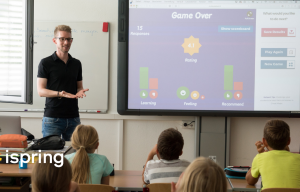5 Must-Join Free Communities for Instructional Designers

Sometimes it can feel like you’re on your own as an Instructional Designer. You’re deep in a storyboard, wrestling with a new authoring tool, or explaining “scenario-based learning” for the fifth time to a stakeholder who just doesn’t get it.
Sure, the official training got you started, but the real magic, the tips that actually work, and those little “aha!” moments? That happens in the wild, wonderful chaos of a community.
We’re talking spaces where IDs from all over swap battle stories, geek out over learning theory, and cheer each other on. These are the places where you get unstuck, inspired, and sometimes even a little career boost along the way.
Here are the top free communities to jump into today to level up your ID game.
1. The iSpring Learning Exchange on LinkedIn
Vibe: Corporate, professional, and practical.
Best For: Tool-agnostic tips, real-world L&D discussions, and industry trends.
The iSpring Learning Exchange Community on LinkedIn has grown from a tool-specific forum into a full-fledged ID hangout. It’s not just about troubleshooting iSpring Suite. It’s about the bigger picture of corporate learning and development.
- What to Expect: You’ll find a mix of insightful articles from L&D leaders and debates over measuring the ROI of soft skills training. Members range from solo instructional designers to Chief Learning Officers, so the perspectives are wide and varied.
- How to Get Value: Don’t be a silent observer. Jump in when someone asks about overcoming stakeholder pushback or designing for microlearning ─ your experience matters. Share, comment, and ask questions. This is also the place to see what’s shaping corporate L&D ─ and stay ahead of trends.
2. The Instructional Design Subreddits (r/instructionaldesign)
The Vibe: Unfiltered, anonymous, and brutally honest.
Best For: Candid career advice, portfolio reviews, and peer support.
Reddit offers a raw and authentic community experience through its subreddits. The main hub, r/instructionaldesign, is a treasure trove of information you won’t always find in more polished, professionally-moderated groups.
- What to Expect: Content is user-driven. You’ll see threads like “Just got laid off, what now?,” “Roast my portfolio,” and “Is a Master’s in ID worth it?” The anonymity allows for frank discussions about salaries, workplace frustrations, and the very real challenges of breaking into the field.
- How to Get Value: Use the search function! Chances are, your questions about transitioning from teaching, preparing for an interview, or finding eLearning examples have been asked and answered in detail. Participate in the weekly threads and be prepared for direct, no-nonsense feedback. It’s one of the best places for genuine, unfiltered peer support.
3. The eLearning and Instructional Design Community
Vibe: Encouraging, beginner-friendly, and design-centric.
Best For: Visual design skills, starting in ID, and positive reinforcement.
Tim Slade, a well-known eLearning author and speaker, has cultivated a wonderfully supportive community on LinkedIn. The focus here is on the “art” of instructional design. More specifically, visual and graphic design principles.
- What to Expect: This community is a safe space for those who feel intimidated by design. Members frequently share their work for constructive feedback, and Tim himself often chimes in with tips and resources. The discussions are less about corporate politics and more about crafting beautiful, effective learning experiences.
- How to Get Value: If you struggle to make your courses look professional, this is your home. Participate in design challenges, ask “stupid” questions about color theory or font pairing, and absorb the encouraging atmosphere. It’s a fantastic antidote to imposter syndrome.
4. The Instructional Designer Group on Facebook
Vibe: Massive, active, and resource-rich.
Best For: Job hunting, daily Q&A, and a wide network.
With tens of thousands of members, the Instructional Designer Group on Facebook is one of the largest and most active free ID communities in the world. The sheer volume of daily posts means there’s always something new to discover.
- What to Expect: This group is a microcosm of the entire ID field. In a single scroll, you might find a job posting for a remote contract role, a question about SCORM, a debate on post-pandemic learning modalities, and someone sharing a free webinar on gamification.
- How to Get Value: Be specific in your questions. Instead of “How do I get into ID?” try “I’m a former teacher applying for a corporate ID role. What’s the best way to frame my K-12 experience on my resume?” The community is incredibly generous but responds best to well-defined queries. It’s also one of the best places for finding immediate contract work and discovering shared resources: free eLearning templates, portfolio examples, and practical tools you can put to use right away.
5. The Learning and Development Collective
Vibe: Thoughtful, strategic, and forward-thinking.
Best For: Deep dives into L&D strategy, research, and professional development.
This community, often found through its website and active LinkedIn presence, positions itself as a home for those who want to elevate the strategic impact of L&D. It’s for practitioners who think beyond course creation and about driving organizational performance.
- What to Expect: Discussions here are less about “how to build a quiz” and more about “how to prove a learning program improved sales performance.” You’ll find conversations around consulting with business leaders, leveraging data and analytics, and implementing emerging technologies like AI in learning.
- How to Get Value: Engage with the strategic content. Share your successes and failures in trying to align learning initiatives with business goals. This is the community that will help you transition from an order-taker to a strategic partner.
How to Thrive in Any ID Community
Joining a community is the first step. Becoming a valued member is what brings the real ROI. Here’s how to make the most of your experience:
- Observe first, then engage: Spend a week observing the culture, the common questions, and the tone. This helps you avoid asking a question that was just answered yesterday.
- Give more than you take: The golden rule of communities. Answer a question for someone else, share a useful resource you found, or provide constructive feedback on a portfolio. Your social capital grows with every contribution.
- Be specific and show your work: When asking for feedback, don’t just post a link. Provide context. “This is for new hire onboarding. My challenge was making policy information engaging. I’m particularly unsure about the practice scenario on slide 4.” This elicits far more useful responses.
- Network with intent: Connect with people whose contributions you admire. Send a personalized connection request mentioning a specific post of theirs you found valuable. Don’t just collect contacts; build your network.
- Remember, it’s a community, not a customer service desk: These are peers volunteering their time. Be respectful, patient, and grateful. A simple “Thank you, that was really helpful!” goes a long way.
The field of Instructional Design is as much about connection as it is about content. By stepping into these diverse, free communities, you connect with a world of inspiration, support, and collective wisdom.




